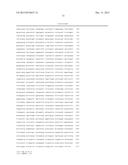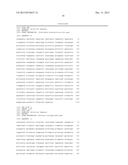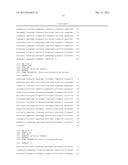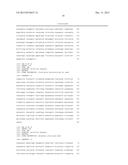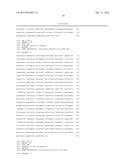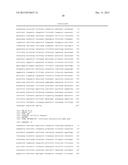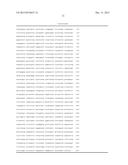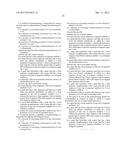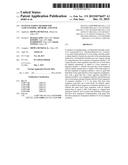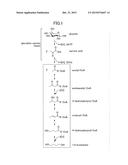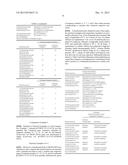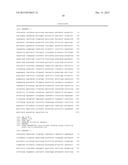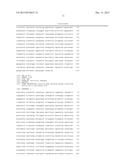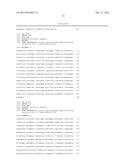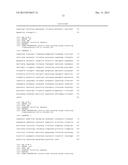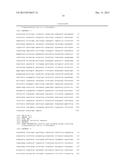Patent application title: MANUFACTURING METHOD FOR 1,4-BUTANEDIOL, MICROBE, AND GENE
Inventors:
Hirobumi Aoki (Tokyo, JP)
Yuzuru Kokido (Tokyo, JP)
Yoko Hashimoto (Tokyo, JP)
Tadashi Yoneda (Tokyo, JP)
Tadashi Yoneda (Tokyo, JP)
Assignees:
SHOWA DENKO K. K.
IPC8 Class: AC12P718FI
USPC Class:
435158
Class name: Containing hydroxy group acyclic polyhydric
Publication date: 2015-12-31
Patent application number: 20150376657
Abstract:
A method of manufacturing 1,4-butanediol through acetyl-CoA,
acetoacetyl-CoA, 3-hydroxybutyryl-CoA, crotonyl-CoA, and
4-hydroxybutyryl-CoA by using a microbe and/or a culture thereof, wherein
the microbe in the manufacturing method for 1,4-butanediol includes any
one of genes among (a) a gene that has a base sequence of sequence number
1, (b) a gene that has a base sequence such that one or more bases are
deleted, substituted, or added in a base sequence of sequence number 1,
wherein the gene has a base sequence with an identity greater than or
equal to 90% with respect to the base sequence of sequence number 1, and
(c) a gene that hybridizes with a gene that has a base sequence
complementary with a gene that has a base sequence described in sequence
number 1 on a stringent condition, and includes any one or more genes
among (d) genes that have base sequences of sequence numbers 2 to 9, (e)
genes that have base sequences such that one or more bases are deleted,
substituted, or added in base sequences of sequence numbers 2 to 9,
wherein the genes have base sequences with an identity greater than or
equal to 90% with respect to original base sequences thereof, and (f)
genes that hybridize with genes that have base sequences complementary
with genes that have base sequences of sequence numbers 2 to 9 on a
stringent condition.Claims:
1. A method of manufacturing 1,4-butanediol by using a microbe and/or a
culture thereof, through the following processes: (1) a process of
converting acetyl-CoA into acetoacetyl-CoA; (2) a process of converting
acetoacetyl-CoA into 3-hydroxybutyryl-CoA; (3) a process of converting
3-hydroxybutyryl-CoA into crotonyl-CoA; (4) a process of converting
crotonyl-CoA into 4-hydroxybutyryl-CoA; and (5) a process of converting
4-hydroxybutyryl-CoA into 1,4-butanediol, wherein the microbe in the
manufacturing method for 1,4-butanediol includes any one of genes among:
(a) a gene that has a base sequence of sequence number 1; (b) a gene that
has a base sequence such that one or more bases are deleted, substituted,
or added in a base sequence of sequence number 1, wherein the gene has a
base sequence with an identity greater than or equal to 90% with respect
to the base sequence of sequence number 1; and (c) a gene that hybridizes
with a gene that has a base sequence complementary with a gene that has a
base sequence described in sequence number 1 on a stringent condition; as
a gene that codes an enzyme that catalyzes a process of (4) described
above; and includes any one or more genes among: (d) a gene that has a
base sequence of any one of sequence numbers 2 to 9; (e) a gene that has
a base sequence such that one or more bases are deleted, substituted, or
added in a base sequence of any one of sequence numbers 2 to 9, wherein
the gene has a base sequence with an identity greater than or equal to
90% with respect to an original base sequence thereof; and (f) a gene
that hybridizes with a gene that has a base sequence complementary with a
gene that has a base sequence of any one of sequence numbers 2 to 9 on a
stringent condition; as a gene that codes an enzyme that catalyzes any
one of processes of (1)-(3) and (5) described above.
2. A microbe that has a capability of manufacturing 1,4-butanediol through the following processes: (1) a process of converting acetyl-CoA into acetoacetyl-CoA; (2) a process of converting acetoacetyl-CoA into 3-hydroxybutyryl-CoA; (3) a process of converting 3-hydroxybutyryl-CoA into crotonyl-CoA; (4) a process of converting crotonyl-CoA into 4-hydroxybutyryl-CoA; and (5) a process of converting 4-hydroxybutyryl-CoA into 1,4-butanediol, wherein the microbe includes any one of genes among: (a) a gene that has a base sequence of sequence number 1; (b) a gene that has a base sequence such that one or more bases are deleted, substituted, or added in a base sequence of sequence number 1, wherein the gene has a base sequence with an identity greater than or equal to 90% with respect to the base sequence of sequence number 1; and (c) a gene that hybridizes with a gene that has a base sequence complementary with a gene that has a base sequence described in sequence number 1 on a stringent condition; as a gene that codes an enzyme that catalyzes a process of (4) described above; and includes any one or more genes among: (d) a gene that has a base sequence of any one of sequence numbers 2 to 9; (e) a gene that has a base sequence such that one or more bases are deleted, substituted, or added in a base sequence of any one of sequence numbers 2 to 9, wherein the gene has a base sequence with an identity greater than or equal to 90% with respect to an original base sequence thereof; and (f) a gene that hybridizes with a gene that has a base sequence complementary with a gene that has a base sequence of any one of sequence numbers 2 to 9 on a stringent condition; as a gene that codes an enzyme that catalyzes any one of processes of (1)-(3) and (5) described above.
3. The gene to be used in the manufacturing method for 1,4-butanediol as claimed in claim 1, which is a gene described in any one of under-mentioned (a)-(c): (a) a gene that has a base sequence of any one of sequence numbers 1 to 9 (b) a gene that has a base sequence such that one or more bases are deleted, substituted, or added in a base sequence of any one of sequence numbers 1 to 9, wherein the gene has a base sequence with an identity greater than or equal to 90% with respect to an original base sequence thereof (c) a gene that hybridizes with a gene that has a base sequence complementary with a gene that has a base sequence of any one of sequence numbers 1 to 9 on a stringent condition.
Description:
TECHNICAL FIELD
[0001] The present invention relates to a manufacturing method for 1,4-butanediol, a microbe, and a gene.
BACKGROUND ART
[0002] In recent years, attention is paid to a compound manufacturing process with a renewable source as a raw material from the viewpoint of depletion of fossil resource, a countermeasure for global warming, or the like. In particular, a so-called bio-refinery has widely been studied wherein a variety of compounds as raw materials for a polymer or compounds as raw materials for a chemical product are manufactured in biochemical processes with biomass as raw materials.
[0003] For a compound that is expected for raw material conversion of biomass, 1,4-butanediol is provided. 1,4-butanediol is widely used as a synthetic raw material for a precision organic chemical product, monomer units of a polyester and an engineering plastic, or the like, and a market size thereof is large. For that reason, demand for a method of manufacturing 1,4-butanediol efficiently in a biochemical process with a renewable source such as biomass as a raw material is increased.
[0004] For manufacturing methods for 1,4-butanediol that use a biochemical process, there are provided, for example, methods described in patent documents 1 and 2 and non-patent document 1.
PRIOR ART DOCUMENTS
[0005] [Patent Document 1] Japanese Patent No. 4380704 specification
[0006] [Patent Document 2] International Publication No. 2008/115840 official gazette
[0007] [Non-patent document 1] Harry Yim et al., Metabolic engineering of Escherichia coli for direct production of 1,4-butanediol, Nature Chemical Biology, 7, 445-452 (2011).
DISCLOSURE OF THE INVENTION
Problems to be Solved by the Invention
[0008] However, methods described in patent documents 1 and 2 and non-patent document 1 are complicated processes.
[0009] Against a problem as described above, there is provided a new manufacturing method for 1,4-butanediol that is capable of obtaining 1,4-butanediol economically.
Means for Solving the Problem
[0010] The present invention includes the following.
[0011] [1]A method of manufacturing 1,4-butanediol by using a microbe and/or a culture thereof, through the following processes:
[0012] (1) a process of converting acetyl-CoA into acetoacetyl-CoA;
[0013] (2) a process of converting acetoacetyl-CoA into 3-hydroxybutyryl-CoA;
[0014] (3) a process of converting 3-hydroxybutyryl-CoA into crotonyl-CoA;
[0015] (4) a process of converting crotonyl-CoA into 4-hydroxybutyryl-CoA; and
[0016] (5) a process of converting 4-hydroxybutyryl-CoA into 1,4-butanediol,
[0017] wherein the microbe in the manufacturing method for 1,4-butanediol
[0018] includes any one of genes among:
[0019] (a) a gene that has a base sequence of sequence number 1;
[0020] (b) a gene that has a base sequence such that one or more bases are deleted, substituted, or added in a base sequence of sequence number 1, wherein the gene has a base sequence with an identity greater than or equal to 90% with respect to the base sequence of sequence number 1; and
[0021] (c) a gene that hybridizes with a gene that has a base sequence complementary with a gene that has a base sequence described in sequence number 1 on a stringent condition;
[0022] as a gene that codes an enzyme that catalyzes a process of (4) described above; and
[0023] includes any one or more genes among:
[0024] (d) a gene that has a base sequence of any one of sequence numbers 2 to 9;
[0025] (e) a gene that has a base sequence such that one or more bases are deleted, substituted, or added in a base sequence of any one of sequence numbers 2 to 9, wherein the gene has a base sequence with an identity greater than or equal to 90% with respect to an original base sequence thereof; and
[0026] (f) a gene that hybridizes with a gene that has a base sequence complementary with a gene that has a base sequence of any one of sequence numbers 2 to 9 on a stringent condition;
[0027] as a gene that codes an enzyme that catalyzes any one of processes of (1)-(3) and (5) described above.
[0028] [2]A microbe that has a capability of manufacturing 1,4-butanediol through the following processes:
[0029] (1) a process of converting acetyl-CoA into acetoacetyl-CoA;
[0030] (2) a process of converting acetoacetyl-CoA into 3-hydroxybutyryl-CoA;
[0031] (3) a process of converting 3-hydroxybutyryl-CoA into crotonyl-CoA;
[0032] (4) a process of converting crotonyl-CoA into 4-hydroxybutyryl-CoA; and
[0033] (5) a process of converting 4-hydroxybutyryl-CoA into 1,4-butanediol,
[0034] wherein the microbe
[0035] includes any one of genes among:
[0036] (a) a gene that has a base sequence of sequence number 1;
[0037] (b) a gene that has a base sequence such that one or more bases are deleted, substituted, or added in a base sequence of sequence number 1, wherein the gene has a base sequence with an identity greater than or equal to 90% with respect to the base sequence of sequence number 1; and
[0038] (c) a gene that hybridizes with a gene that has a base sequence complementary with a gene that has a base sequence described in sequence number 1 on a stringent condition;
[0039] as a gene that codes an enzyme that catalyzes a process of (4) described above; and
[0040] includes any one or more genes among:
[0041] (d) a gene that has a base sequence of any one of sequence numbers 2 to 9;
[0042] (e) a gene that has a base sequence such that one or more bases are deleted, substituted, or added in a base sequence of any one of sequence numbers 2 to 9, wherein the gene has a base sequence with an identity greater than or equal to 90% with respect to an original base sequence thereof; and
[0043] (f) a gene that hybridizes with a gene that has a base sequence complementary with a gene that has a base sequence of any one of sequence numbers 2 to 9 on a stringent condition;
[0044] as a gene that codes an enzyme that catalyzes any one of processes of (1)-(3) and (5) described above.
[0045] [3] The gene to be used in the manufacturing method for 1,4-butanediol described in [1], which is a gene described in any one of under-mentioned (a)-(c):
[0046] (a) a gene that has a base sequence of any one of sequence numbers 1 to 9
[0047] (b) a gene that has a base sequence such that one or more bases are deleted, substituted, or added in a base sequence of any one of sequence numbers 1 to 9, wherein the gene has a base sequence with an identity greater than or equal to 90% with respect to an original base sequence thereof
[0048] (c) a gene that hybridizes with a gene that has a base sequence complementary with a gene that has a base sequence of any one of sequence numbers 1 to 9 on a stringent condition.
Effects of the Invention
[0049] It is possible to provide a new manufacturing method for 1,4-butanediol that is capable of obtaining 1,4-butanediol economically.
BRIEF DESCRIPTION OF THE DRAWINGS
[0050] FIG. 1 is one example of an enzymatic system of a manufacturing method for 1,4-butanediol according to the present embodiment.
BEST MODE FOR IMPLEMENTING THE INVENTION
[0051] The present invention will be described in detail below. Here, "CoA" in the present specification means "coenzyme A". Furthermore, "%" indicates "% by mass" unless otherwise described. "ppm" is a mass standard.
[0052] A manufacturing method for 1,4-butanediol according to an embodiment is a manufacturing method for 1,4-butanediol that relies on an enzyme reaction that uses a microbe or a culture thereof, through acetyl-CoA, acetoacetyl-CoA, 3-hydroxybutyryl-CoA, crotonyl-CoA, and 4-hydroxybutyryl-CoA.
[0053] Specifically, each enzyme reaction includes:
[0054] (1) a process of converting acetyl-CoA into acetoacetyl-CoA;
[0055] (2) a process of converting acetoacetyl-CoA into 3-hydroxybutyryl-CoA;
[0056] (3) a process of converting 3-hydroxybutyryl-CoA into crotonyl-CoA;
[0057] (4) a process of converting crotonyl-CoA into 4-hydroxybutyryl-CoA; and
[0058] (5) a process of converting 4-hydroxybutyryl-CoA into 1,4-butanediol.
[0059] The present inventors executed a variety of studies in order to improve productivity of 1,4-butanediol, and as a result, found that it was possible to obtain 1,4-butanediol at a high productivity by using a particular gene or a homolog thereof in a gene that codes an enzyme that catalyzes each reaction in a process as described above.
[0060] For a particular gene as described previously, specifically, any one of genes among:
[0061] (a) a gene that has a base sequence of sequence number 1;
[0062] (b) a gene that has a base sequence such that one or more bases are deleted, substituted, or added in a base sequence of sequence number 1, wherein the gene has a base sequence with an identity greater than or equal to 90% with respect to the base sequence of sequence number 1; and
[0063] (c) a gene that hybridizes with a gene that has a base sequence complementary with a gene that has a base sequence described in sequence number 1 on a stringent condition;
is preferably used as a gene that codes an enzyme that catalyzes a reaction in (4) a process of converting crotonyl-CoA into 4-hydroxybutyryl-CoA.
[0064] Furthermore, any one of genes among:
[0065] (a) a gene that has a base sequence of any one of sequence numbers 2 to 9;
[0066] (b) a gene that has a base sequence such that one or more bases are deleted, substituted, or added in a base sequence of any one of sequence numbers 2 to 9, wherein the gene has a base sequence with an identity greater than or equal to 90% with respect to a base sequence of sequence number 1; and
[0067] (c) a gene that hybridizes with a gene that has a base sequence complementary with a gene that has a base sequence of any one of sequence numbers 2 to 9 on a stringent condition;
is preferably used as a gene that codes an enzyme that catalyzes a corresponding conversion reaction in any one or more processes among other processes (1), (2), (3), and (5).
[0068] In the present embodiment, a particular gene as described above includes a gene that has a base sequence that is specifically indicated in a sequence listing, and a homolog thereof. A homolog includes an ortholog and a paralog. An ortholog refers to a set of corresponding genes among species generated from a gene of a common ancestor by means of speciation and enzymes obtained from such genes. A paralog refers to corresponding genes among species generated by means of not speciation but gene duplication in an identical species and enzymes obtained from such genes. A homolog refers to genes that have an identity in sequences thereof, regardless of an ortholog or a paralog, and enzymes obtained from such genes.
[0069] More specifically, a homolog (gene) of a gene as described above refers to a gene that has a base sequence with an identity greater than or equal to 90%, preferably an identity greater than or equal to 95%, with respect to such a gene, and more preferably, a gene that is completely identical to such a gene or wherein one or several bases thereof are deleted, substituted, or added.
[0070] Furthermore, a homolog gene includes a gene that hybridizes with a gene that has a base sequence complementary with a target gene on a stringent condition. Specifically, it is possible to acquire a gene or an enzyme that is obtained by transformation caused by such a gene, by applying a homology retrieval program (for example, BLAST or FASTA) to a publicly-known data base, or based on an ordinary method such as hybridization or polymerase chain reaction (PCR) on a stringent condition that uses a probe that is composed of at least a portion of an identified gene (DNA that is composed of a base sequence complementary with DNA that is composed of a base sequence of such a gene). Furthermore, it is possible for a person(s) skilled in the art to execute self-design by substituting a base sequence or the like. Here, for a stringent condition referred herein, there is provided, for example, a condition for executing hybridization described in a non-patent document of Molecular Cloning--A LABORATORY MANUAL THIRD EDITION (Joseph Sambrook, David W. Russell., Cold Spring Harbor Laboratory Press). More specifically, a hybridizing condition is a condition that retention with a probe in a solution that contains 6×SSC (a composition of 1×SSC: 0.15 M of sodium chloride, 0.015 M of sodium citrate, pH: 7.0), 0.5% of SDS, 5×Denhardt's solution, and 100 mg/mL of herring sperm DNA, at a constant temperature of 65° C. for 8-16 hours is executed to cause hybridization.
[0071] In the present invention, for example, a reaction is caused to proceed, by expressing (that may be co-expressing) an enzyme or a series or group of enzymes that is/are coded by each gene, that is selected as described above, in a body of a microbe provided in such a manner that a host microbe as described below is transformed by means of gene recombination.
[0072] A feature of a microbe that is used in the present embodiment, a fabrication method for the microbe, a method of use of the microbe (that is, a manufacturing method for 1,4-butanediol), an acquisition method of manufactured 1,4-butanediol, and the like, will be described below.
[0073] (A Host Microbe)
[0074] A host microbe that is used in the present embodiment is a host microbe that is capable of introducing a variety of genes as described below, and for example, it is possible to apply a gene recombination technique to a host microbe.
[0075] An example of a host microbe that is capable of introducing a gene as described above in the present embodiment is not particularly limited as long as it is possible to apply a gene recombination technique to such a microbe. From the viewpoint of industrial availability, there is provided Escherichia coli, a yeast, a coryneform bacteria, or a clostridial bacteria, as a specific example. For a yeast, there is provided Saccharomyces cerevisiae, Schizosaccharomyces pombe, Kluyveromyces lactis, Kluyveromyces marxianus, or the like. For a coryneform bacteria, there is provided, Corynebacterium glutamicum, Corynebacterium efficiens, Brevibacterium divaricatum, Brevibacterium saccharolyticum, Brevibacterium immariophilum, Brevibacterium lactofermentum, Brevibacterium roseum, Brevibacterium flavum, Brevibacterium thiogenitalis, Corynebacterium acetoacidophilum, Corynebacterium acetoglutamicum, Corynebacterium callunae, Corynebacterium lilium, Corynebacterium mellassecola, Microbacterium ammoniaphilum, or the like. For a clostridial bacteria, there is provided Clostridium kluyveri, Clostridium acetobutylicum, Clostridium aminobutyricum, Clostridium beijerinckii, Clostridium saccharoperbutylacetonicum, or the like. Among these, it is preferable to use Escherichia coli, Saccharomyces cerevisiae, Schizosaccharomyces pombe, or Corynebacterium glutamicum, because transformation thereof is easy, and it is more preferable to use Escherichia coli.
[0076] Furthermore, a transformed microbe in the present embodiment may be used as a microbe culture bacterial body itself or a variety of forms of a culture thereof. Specifically, a culture of a microbe in the present embodiment includes a suspension of a microbe culture bacterial body in a medium such as a culture medium or a buffer solution, a cell-free extracted fluid from a microbe culture bacterial body, and further, a product processed by concentrating, purifying, and extracting a component that catalyzes such a reaction from such a cell-free extracted fluid or the like. A culture of a microbe in the present embodiment further includes the above-mentioned processed product of a microbe that is fixed on a poorly soluble carrier. For such a fixation carrier, there is provided a compound that forms a poorly water-soluble solid content that encloses a microbial or bacterial body as described previously or a processed product thereof, such as polyacrylamide, polyvinyl alcohol, poly-N-vinylformamide, polyallylamine, polyethyleneimine, methylcellulose, glucomannan, alginate, or carrageenan, or further a copolymer or crosslinked product thereof, or the like. One kind of these may be used singly or two or more kinds thereof may be mixed and used. Furthermore, it is also possible to use, as a culture of a microbe, a microbe or an extracted fluid or extracted component thereof that is held on an object that is preliminarily formed as a solid, such as activated carbon, a porous ceramic, glass fiber, a porous polymer molded object, or a nitrocellulose film.
[0077] (A Transformed Microbe)
[0078] A host microbe that is used in the present embodiment is a host microbe that is capable of introducing a variety of genes as described below, wherein it is possible to apply, for example, a gene recombination technique to such a host microbe. Specifically, such a host microbe further has each enzyme system of an enzyme reaction system that is capable of producing 1,4-butanediol through acetyl-CoA, acetoacetyl-CoA, 3-hydroxybutyryl-CoA, crotonyl-CoA, and 4-hydroxybutyryl-CoA, in addition to an enzyme system that is intrinsically possessed thereby. An enzyme system in a manufacturing method for 1,4-butanediol according to the present embodiment and a gene that codes each enzyme system will be described below.
[0079] FIG. 1 illustrates one example of an enzyme system in a manufacturing method for 1,4-butanediol according to the present embodiment. In the present embodiment, it is possible to obtain 1,4-butanediol by using a culture that is expressed in a microbial body by transforming a series of genes as described below or the like. Here, a gene is inserted into an arbitrary vector individually or as a series of clusters so that a host microbe is transformed. An obtained transformed body is cultured in a culture medium with an appropriate carbon source, for example, glucose as a carbon source, so that each gene is expressed. In a case of a gene capable of being constitutively expressed in a host, a transformed body is cultured in a culture medium so that such a gene is expressed. On the other hand, in a case where each gene is constituted under a control of a regulator disposed on a vector, an inducible substrate is added to transfer to inductive environment, and thereby, each coding gene is expressed. Here, culturing in the present embodiment includes all of culturing conditions for a normal microbe culturing, and further, culturing in the present embodiment means that a microbe is cultured for a period of time and a condition enough to manufacture 1,4-butanediol.
[0080] [A gene that catalyzes a reaction that converts acetyl-CoA into acetoacetyl-CoA]
[0081] For a gene that codes an enzyme that catalyzes a reaction that converts acetyl-CoA into acetoacetyl-CoA in the present embodiment,
[0082] (a) a gene that has a base sequence of sequence number 2;
[0083] (b) a gene that has a base sequence such that one or more bases are deleted, substituted, or added in a base sequence of sequence number 2, wherein the gene has a base sequence with an identity greater than or equal to 90% with respect to the base sequence of sequence number 2; or
[0084] (c) a gene that hybridizes with a gene that has a base sequence complementary with a gene that has a base sequence described in sequence number 2 on a stringent condition;
is preferably used that is provided by the inventors.
[0085] Furthermore, for a gene that codes an enzyme that catalyzes a reaction that converts acetyl-CoA into acetoacetyl-CoA in the present embodiment,
[0086] (a) a gene that has a base sequence of sequence number 3;
[0087] (b) a gene that has a base sequence such that one or more bases are deleted, substituted, or added in a base sequence of sequence number 3, wherein the gene has a base sequence with an identity greater than or equal to 90% with respect to the base sequence of sequence number 3; or
[0088] (c) a gene that hybridizes with a gene that has a base sequence complementary with a gene that has a base sequence described in sequence number 3 on a stringent condition;
is preferably used that is provided by the inventors.
[0089] [A gene that catalyzes a reaction that converts acetoacetyl-CoA into 3-hydroxybutyryl-CoA]
[0090] For a gene that codes an enzyme that catalyzes a reaction that converts acetoacetyl-CoA into 3-hydroxybutyryl-CoA in the present embodiment,
[0091] (a) a gene that has a base sequence of sequence number 4;
[0092] (b) a gene that has a base sequence such that one or more bases are deleted, substituted, or added in a base sequence of sequence number 4, wherein the gene has a base sequence with an identity greater than or equal to 90% with respect to the base sequence of sequence number 4; or
[0093] (c) a gene that hybridizes with a gene that has a base sequence complementary with a gene that has a base sequence described in sequence number 4 on a stringent condition;
is preferably used that is provided by the inventors.
[0094] Furthermore, for a gene that codes an enzyme that catalyzes a reaction that converts acetoacetyl-CoA into 3-hydroxybutyryl-CoA in the present embodiment,
[0095] (a) a gene that has a base sequence of sequence number 5;
[0096] (b) a gene that has a base sequence such that one or more bases are deleted, substituted, or added in a base sequence of sequence number 5, wherein the gene has a base sequence with an identity greater than or equal to 90% with respect to the base sequence of sequence number 5; or
[0097] (c) a gene that hybridizes with a gene that has a base sequence complementary with a gene that has a base sequence described in sequence number 5 on a stringent condition;
is preferably used that is provided by the inventors.
[0098] [A gene that codes an enzyme that catalyzes a reaction that converts 3-hydroxybutyryl-CoA into crotonyl-CoA]
[0099] For a gene that codes an enzyme that catalyzes a reaction that converts 3-hydroxybutyryl-CoA into crotonyl-CoA in the present embodiment,
[0100] (a) a gene that has a base sequence of sequence number 6;
[0101] (b) a gene that has a base sequence such that one or more bases are deleted, substituted, or added in a base sequence of sequence number 6, wherein the gene has a base sequence with an identity greater than or equal to 90% with respect to the base sequence of sequence number 6; or
[0102] (c) a gene that hybridizes with a gene that has a base sequence complementary with a gene that has a base sequence described in sequence number 6 on a stringent condition;
is preferably used that is provided by the inventors.
[0103] Furthermore, for a gene that codes an enzyme that catalyzes a reaction that converts 3-hydroxybutyryl-CoA into crotonyl-CoA in the present embodiment,
[0104] (a) a gene that has a base sequence of sequence number 7;
[0105] (b) a gene that has a base sequence such that one or more bases are deleted, substituted, or added in a base sequence of sequence number 7, wherein the gene has a base sequence with an identity greater than or equal to 90% with respect to the base sequence of sequence number 7; or
[0106] (c) a gene that hybridizes with a gene that has a base sequence complementary with a gene that has a base sequence described in sequence number 7 on a stringent condition;
is preferably used that is provided by the inventors.
[0107] [A gene that codes an enzyme that catalyzes a reaction that converts crotonyl-CoA into 4-hydroxybutyryl-CoA]
[0108] For a gene that codes an enzyme that catalyzes a reaction that converts crotonyl-CoA into 4-hydroxybutyryl-CoA in the present embodiment,
[0109] (a) a gene that has a base sequence of sequence number 1;
[0110] (b) a gene that has a base sequence such that one or more bases are deleted, substituted, or added in a base sequence of sequence number 1, wherein the gene has a base sequence with an identity greater than or equal to 90% with respect to the base sequence of sequence number 1; or
[0111] (c) a gene that hybridizes with a gene that has a base sequence complementary with a gene that has a base sequence described in sequence number 1 on a stringent condition;
is preferably used that is provided by the inventors.
[0112] [A gene that codes an enzyme that catalyzes a reaction that converts 4-hydroxybutyryl-CoA into 1,4-butanediol]
[0113] For a gene that codes an enzyme that catalyzes a reaction that converts 4-hydroxybutyryl-CoA into 1,4-butanediol in the present embodiment,
[0114] (a) a gene that has a base sequence of sequence number 8;
[0115] (b) a gene that has a base sequence such that one or more bases are deleted, substituted, or added in a base sequence of sequence number 8, wherein the gene has a base sequence with an identity greater than or equal to 90% with respect to the base sequence of sequence number 8; or
[0116] (c) a gene that hybridizes with a gene that has a base sequence complementary with a gene that has a base sequence described in sequence number 8 on a stringent condition;
is preferably used that is provided by the inventors.
[0117] Furthermore, for a gene that codes an enzyme that catalyzes a reaction that converts 4-hydroxybutyryl-CoA into 1,4-butanediol in the present embodiment,
[0118] (a) a gene that has a base sequence of sequence number 9;
[0119] (b) a gene that has a base sequence such that one or more bases are deleted, substituted, or added in a base sequence of sequence number 9, wherein the gene has a base sequence with an identity greater than or equal to 90% with respect to the base sequence of sequence number 9; or
[0120] (c) a gene that hybridizes with a gene that has a base sequence complementary with a gene that has a base sequence described in sequence number 9 on a stringent condition;
is preferably used that is provided by the inventors.
[0121] Here, an enzyme that is coded by a gene as described above catalyzes a reaction that converts 4-hydroxybutyryl-CoA into 4-hydroxybutanal, and 1,4-butanediol is substantially and immediately derived from obtained 4-hydroxybutanal by an alcohol reductase that is normally possessed by a host microbe as described previously.
[0122] [Supply of Acetyl-CoA]
[0123] A supply method for acetyl-CoA that is a substrate in a manufacturing method for 1,4-butanediol according to the present embodiment is not particularly limited and a variety of known methods are used. For example, it is possible to be obtained from a saccharide such as glucose due to a glycolytic system of a host microbe. Furthermore, it is also possible to obtain acetyl-CoA in a pathway of β-oxidation of a lipid. Moreover, acetyl-CoA may be supplied by using a CoA transferase in such a manner that CoA is transferred to acetic acid by means of coupling with an appropriate CoA material.
[0124] (A Fabrication Method for a Microbe)
[0125] It is possible to execute introduction of a gene into a host microbe by appropriately combining and using a variety of known methods, for example, a method based on a restriction enzyme/ligation, an In-Fusion cloning method, and the like, so that a gene as described above or a part thereof is linked with an appropriate vector and an obtained recombinant vector is introduced into a host in such a manner that it is possible for a target gene to be expressed. Alternatively, it is possible to insert a target gene or a part thereof at an arbitrary position on genome by means of homologous recombination. A "part" refers to a part of each gene that is capable of expressing a protein that is coded by each gene in a case of being introduced into a host. A gene in the present invention encompasses DNA and RNA, and preferably, is DNA.
[0126] A vector that is linked with a gene as described previously is not particularly limited as long as it is possible to execute replication thereof in a host, and there are provided, for example, a plasmid, a phage, a cosmid, and the like, that are utilized for introduction of an exotic gene into Escherichia coli. For a plasmid, there is provided, for example, pHSG398, pUC18, pBR322, pSC101, pUC19, pUC118, pUC119, pACYC117, pBluescript II SK(+), pET17b, pETDuet-1, pACYCDuet-1, pCDFDuet-1, pRSFDuet-1, pCOLADuet-1, or the like, and for a phage, there is provided, for example, λgt10, Charon 4A, EMBL-, M13mp18, M13mp19, or the like. Some of them are commercially available and it is possible to use a commercially available product (kit) directly in accordance with, or by appropriately modifying, a procedure manual thereof.
[0127] In a vector as described above, an appropriate expression promoter may be connected to such a gene upstream thereof so that an inserted gene is expressed reliably. An expression promoter to be used is not particularly limited, and it is possible for a person skilled in the art to make an appropriate selection thereof depending on a host. For example, it is also possible to utilize T7 promoter, lac promoter, trp promoter, trc promoter, or λ-PL promoter that is utilized for expression of an exotic gene in Escherichia coli, or an Nar promoter region of a nitrate reduction gene nar GHJI operon that is derived from Escherichia coli and involved with nitrate respiration, or a promoter region of Frd gene that is a gene of a nitrate reductase of Escherichia coli.
[0128] Furthermore, depending on a case, it is also preferable to destruct an intrinsic gene of a host microbe so that such a gene is not expressed. For a method of gene destruction, it is possible to use a publicly-known method that is utilized for gene destruction in Escherichia coli. Specifically, it is possible to use a method that is used for fabricating a knockout cell or the like in such a technical field, such as a method (gene targeting method) that destructs such a gene by using a vector (targeting vector) that causes homologous recombination at an arbitrary position of a target gene, a method (gene trap method) that inserts a trap vector (reporter gene that does not have a promoter) at an arbitrary position of a target gene to destruct such a gene and be caused to lose a function thereof, or a method of a combination thereof.
[0129] A position that causes homologous substitution or a position for inserting a trap vector is not particularly limited as long as such a position is to cause mutation that eliminates expression of a target gene to be destructed, and is preferably a transcription control region.
[0130] Moreover, a method for introduction of a vector as described previously into a host is not particularly limited, and it is possible to provide, for example, a method that uses a calcium ion, a protoplast method, an electroporation method, or the like, that is generally utilized for introduction of a vector into Escherichia coli.
[0131] A target gene together with a promoter is inserted into a sequence homologous to a sequence on a genome and such a nucleic acid fragment is introduced into a cell by means of electroporation to cause homologous recombination, so that it is possible to practice a method that inserts a target gene at an arbitrary position on a genome by means of homologous recombination. As a nucleic acid fragment wherein a drug resistance gene is linked with a target gene is used in a case of introduction into a genome, it is possible to readily choose a strain wherein homologous recombination is caused. Furthermore, it is also possible to introduce a target gene by means of homologous recombination in such a manner that a gene wherein a gene that is lethal on a particular condition is linked with a drug resistance gene is inserted into a genome by means of homologous recombination in a method as described above and subsequently the drug resistance gene and the gene that is lethal on a particular condition are replaced thereby.
[0132] Moreover, a method that selects a recombinant microbe with an introduced target gene is not particularly limited, and it is preferable to be based on a technique that is capable of readily selecting only a recombinant microbe with an introduced target gene.
[0133] (A culturing method and an acquisition method for obtained 1,4-butanediol)
[0134] For example, a reaction in the present invention is most conveniently achieved in such a manner that a transformed body is cultured in a nutritive medium such as an LB medium at a temperature of 15° C.-40° C., desirably 18° C.-37° C. for about 24 hours, subsequently implanted to a medium with a normal carbon source, for example, a carbon source that is 0.01-50%, desirably 0.1-30%, of glucose, and continuously cultured at a similar temperature for about 1 hour-200 hours, wherein 1,4-butanediol is stored in a culture solution in such a process. Furthermore, a carbon source may be added continuously or intermittently depending on consumption of a carbon source that is caused by proliferation of a bacteria or proceeding of a reaction, and in such a case, a concentration of a carbon source in a reaction fluid is not limited to one described previously.
[0135] As a medium carbon source for culturing a microbe, it is possible to use, for example, a saccharide such as glucose, sucrose, or fructose, a polyol such as glycerol, an organic substance such as ethanol, acetic acid, citric acid, succinic acid, lactic acid, benzoic acid, or a fatty acid, or an alkali metal salt thereof, an aliphatic hydrocarbon such as an n-paraffin, an aromatic hydrocarbon, or a natural organic substance such as peptone, meat extract, fish extract, soybean flour, or bran, singly or in combination thereof, at a concentration of normally 0.01%-30%, desirably about 0.1%-20%.
[0136] For a medium nitrogen source for culturing a microbe, it is possible to use, for example, an inorganic nitrogen compound such as ammonium sulfate, ammonium phosphate, sodium nitrate, or potassium nitrate, a nitrogen-containing organic substance such as urea or uric acid, or a natural organic substance such as peptone, meat extract, fish extract, or soybean flour, singly or in combination thereof, at a concentration of normally 0.01%-20%, desirably about 0.1%-10%.
[0137] Moreover, it is possible to add a phosphate such as potassium dihydrogen phosphate, or a metal salt such as magnesium sulfate, ferrous sulfate, calcium acetate, manganese chloride, copper sulfate, zinc sulfate, cobalt sulfate, or nickel sulfate, as necessary, for growth of a bacteria or improvement of an enzyme activity. A concentration for addition thereof is different depending on a culturing condition, and normally, is 0.01%-5% for a phosphate, 10 ppm-1% for a magnesium salt, or about 0.1 ppm-1,000 ppm for other compounds. Furthermore, for a supply source of a vitamin, an amino acid, a nucleic acid, or the like, it is possible to add, for example, about 1 ppm-100 ppm of yeast extract, casamino acid, or a yeast nucleic acid, depending on a selected medium, for growth of a bacteria or improvement of an enzyme activity.
[0138] It is desirable to adjust a pH of a medium to 4.5-9, desirably 5-8. Furthermore, it is useful to fractionate from a culture solution by a method such as centrifugation or membrane filtration, and again suspend and react in water that contains a reaction raw material, physiological saline, a buffer that has a pH adjusted to be comparable to a pH for culturing and composed of phosphoric acid, acetic acid, boric acid, tris(hydroxymethyl)aminomethane, or the like, or a salt thereof, or the like, a microbial or bacterial body that is preliminarily cultured in a medium as described previously, in order to reduce an impurity in a reaction fluid and simplify subsequent fractionation of a product. Although a pH during a reaction is normally capable of being retained in a case where a buffer with a sufficient concentration is used, it is desirable to be execute appropriate adjustment by using sodium hydroxide, ammonia, or the like so as to provide a similar pH in a case where deviation from a pH as described above is caused by proceeding of a reaction.
[0139] In a case where 1,4-butanediol is stored in a reaction fluid and a reaction rate is lowered thereby, a method is preferable that adds water, physiological saline, a reaction buffer, or the like, into such a reaction fluid depending on a concentration of a product to execute continuous dilution thereof. Furthermore, at a point of time when a reaction rate is lowered, a bacteria is fractionated and a supernatant is recovered as a product solution and a fractionated bacteria is again returned to a solution or suspension that contains a reaction raw material, so that it is possible to recover such a reaction rate. It is possible to execute such an operation continuously or even batch-wise by using a centrifuge, a separation film, or the like.
[0140] It is possible to execute separation, recovery, and purification of 1,4-butanediol produced in a reaction fluid by using separation, recovery, and purification means for a general organic compound, after a bacterial body is eliminated from such a reaction fluid by means of centrifugation at a point of time when an amount of produced 1,4-butanediol reaches a substantial amount, or for such a reaction fluid directly. For example, extraction from a filtrate provided in such a manner that a bacterial body and others are eliminated from a culture solution is executed by using an appropriate organic solvent. 1,4-butanediol is obtained at a high purity by directly executing distillation for such an extract, as well as, further executing extraction with an appropriate solvent again, executing purification that uses chromatography on silica gel or the like, or applying multistep distillation or the like thereto.
[0141] (Practical Examples and Comparative Examples)
[0142] Next, the present invention will be described in more detail by describing practical examples.
[0143] Table 1 illustrates a summary of an envisaged reaction process, an enzyme that catalyzes each reaction process, and a gene that codes such an enzyme in Practical Examples 1 to 3 and Comparative Example 1. Here, a sequence number for a gene corresponds to a sequence number in a sequence listing.
TABLE-US-00001 TABLE 1 Enzyme that catalyzes Reaction process corresponding reaction (1) Process that converts β-ketothiolase, acetyl-CoA acetyl acetyl-CoA into transferase, acetoacetyl-CoA synthase acetoacetyl-CoA (EC number: 2.3.1.9) (2) Process that converts 3-hydroxybutyryl-CoA dehydrogenase acetoacetyl-CoA into (EC number: 1.1.1.35), acetoacetyl-CoA 3-hydroxybutyryl-CoA reductase (EC number: 1.1.1.36), 3-hydroxyacyl-CoA dehydrogenase (EC number: 1.1.1.157) (3) Process that converts enoyl-CoA hydratase (EC number: 3-hydroxybutyryl-CoA 4.2.1.17, EC number 4.2.1.119), into crotonyl-CoA 3-hydroxybutyryl-CoA dehydratase (EC number: 4.2.1.55) (4) Process that converts vinylacetyl-CoA delta-isomerase crotonyl-CoA into (EC number: 5.3.3.3) + 4-hydroxybutyryl-CoA 4-hydroxybutyryl-CoA dehydratase (EC number: 4.2.1.120) (5) Process that converts acyl-CoA reductase 4-hydroxybutyryl-CoA (EC number: 1.2.1.10) into 1,4-butanediol Used gene Practical Examples 1-3 and Comparative Example 1 Practical Reaction process Example gene Derivation (1) Process that converts Sequence Provided by inventors acetyl-CoA into number 2 (artificial synthesis) acetoacetyl-CoA (2) Process that converts Sequence Provided by inventors acetoacetyl-CoA into number 4 (artificial synthesis) 3-hydroxybutyryl-CoA (3) Process that converts Sequence Provided by inventors 3-hydroxybutyryl-CoA number 6 (artificial synthesis) into crotonyl-CoA (4) Process that converts Sequence Provided by inventors crotonyl-CoA into number 1 (artificial synthesis) 4-hydroxybutyryl-CoA (5) Process that converts Sequence Provided by inventors 4-hydroxybutyryl-CoA number 8 (artificial synthesis) into 1,4-butanediol Used gene Practical Examples 1-3 and Comparative Example 1 Comparative Reaction process control gene Derivation (1) Process that converts Sequence thiL (Clostridium acetyl-CoA into number 10 acetobutylicum acetoacetyl-CoA ATCC 824-derived sequence, artificial synthesis) (2) Process that converts Sequence hbd (Clostridium acetoacetyl-CoA into number 12 acetobutylicum 3-hydroxybutyryl-CoA ATCC 824-derived sequence, artificial synthesis) (3) Process that converts Sequence crt (Clostridium 3-hydroxybutyryl-CoA number 14 acetobutylicum into crotonyl-CoA ATCC 824-derived sequence, artificial synthesis) (4) Process that converts Sequence abfD (Clostridium crotonyl-CoA into number 16 aminobutylicum 4-hydroxybutyryl-CoA DSM 2634-derived sequence, artificial synthesis) (5) Process that converts Sequence ald (Clostridium 4-hydroxybutyryl-CoA number 17 beijerinckii strain into 1,4-butanediol NRRL B592-derived sequence, artificial synthesis)
Comparative Example 1
[0144] A blunt end fragment was prepared by an ordinary method in such a manner that sequences that corresponded to 15 base pairs at an upstream side and a downstream side that contained CAT at an upstream side and ATG at a downstream side of a NdeI site among multi-cloning sites of expression vector pET17b (produced by Novagen, Inc.), respectively, were added to a 5'-end side and a 3'-end side upstream and downstream a gene sequence indicated by sequence number 10, respectively. Ligation of this fragment and a fragment provided by NdeI-treating pET17b (produced by Novagen, Inc.) was executed by In-Fusion HD Cloning Kit (produced by TAKARA BIO INC.) to obtain plasmid pETBD10.
[0145] A gene sequence indicated by sequence number 12 was inserted into an NdeI site of pET17b as a target by a method similar to that for pETBD10 to obtain plasmid pETBD12 that contained sequence 12.
[0146] An EcoRI site positioned downstream a termination codon of sequence 10 of pETBD10 and derived from multi-cloning sites of pET17b was cleaved by a restriction enzyme treatment to prepare a ring-opened fragment of pETBD10. Then, a fragment was prepared by means of PCR such that sequences that corresponded to 15 bp at an upstream side and 15 bp at a downstream side that contained an EcoRI site of pETBD10 described previously were added upstream and downstream a region of sequence 12 of pETBD12 and a region that contained T7 promoter derived from pET17b upstream thereof. Ligation of two obtained fragments was executed by In-Fusion HD Cloning Kit to obtain plasmid pETBD10-12 that contained sequences 10 and 12.
[0147] Subsequently, sequence numbers 14, 16, and 17 were sequentially added to a sequence downstream sequence 12 of pETBD10-12 as a further target in a similar manner to obtain plasmid pETBD10-12-14-16-17. Here, for addition of a sequence, ring-opening of a plasmid to be subjected to insertion was executed by cleavage with a restriction enzyme in a case where such a suitable restriction enzyme site that did not cleave a sequence subjected to insertion was present on a vector, or inverse PCR from a target site for insertion in a case where such a site was absent (similarly below). Escherichia coli JM109 (DE3) strain was transformed with pETBD10-12-14-16-17 to obtain Escherichia coli pETBD10-12-14-16-17/JM109 (DE3).
Practical Examples 1 to 3
[0148] A transformed body of JM109 (DE3) was obtained by a method similar to that of Comparative Example 1 in such a manner that transformation was executed with a plasmid provided in such a manner that respective genes of sequence numbers 10, 12, 14, 16, and 17 on plasmid pETBD10-12-14-16-17 were partially substituted by genes of sequence numbers 2, 4, 6, 1, and 8 that coded enzymes corresponding to enzymes that catalyzed respective processes.
[0149] Table 2 illustrates a summary of an envisaged reaction process, an enzyme that catalyzes each reaction process, and a gene that codes such an enzyme in Practical Examples 1 to 3 and Comparative Example 1. Here, a sequence number for a gene corresponds to a sequence number in a sequence listing.
TABLE-US-00002 TABLE 2 Enzyme that catalyzes Reaction process corresponding reaction (1) Process that converts β-ketothiolase, acetyl-CoA acetyl acetyl-CoA into transferase, acetoacetyl-CoA synthase acetoacetyl-CoA (EC number: 2.3.1.9) (2) Process that converts 3-hydroxybutyryl-CoA dehydrogenase acetoacetyl-CoA into (EC number: 1.1.1.35), acetoacetyl-CoA 3-hydroxybutyryl-CoA reductase (EC number: 1.1.1.36), 3-hydroxyacyl-CoA dehydrogenase (EC number: 1.1.1.157) (3) Process that converts enoyl-CoA hydratase (EC number: 3-hydroxybutyryl-CoA 4.2.1.17, EC number 4.2.1.119), into crotonyl-CoA 3-hydroxybutyryl-CoA dehydratase (EC number: 4.2.1.55) (4) Process that converts vinylacetyl-CoA delta-isomerase crotonyl-CoA into (EC number: 5.3.3.3) + 4- 4-hydroxybutyryl-CoA hydroxybutyryl-CoA dehydratase (EC number: 4.2.1.120) (5) Process that converts acyl-CoA reductase 4-hydroxybutyryl-CoA (EC number: 1.2.1.10) into 1,4-butanediol Amount of produced 1,4-butanediol (mg/L) Used gene (sequence number) Comparative Practical Reaction process Example 1 Example 1 (1) Process that converts 10 10 acetyl-CoA into acetoacetyl-CoA (2) Process that converts 12 4 acetoacetyl-CoA into 3-hydroxybutyryl-CoA (3) Process that converts 14 14 3-hydroxybutyryl-CoA into crotonyl-CoA (4) Process that converts 16 1 crotonyl-CoA into 4-hydroxybutyryl-CoA (5) Process that converts 17 17 4-hydroxybutyryl-CoA into 1,4-butanediol Amount of produced 1,4- n.d. 24 butanediol (mg/L) Used gene (sequence number) Practical Practical Reaction process Example 2 Example 3 (1) Process that converts 10 2 acetyl-CoA into acetoacetyl-CoA (2) Process that converts 4 4 acetoacetyl-CoA into 3-hydroxybutyryl-CoA (3) Process that converts 14 6 3-hydroxybutyryl-CoA into crotonyl-CoA (4) Process that converts 1 1 crotonyl-CoA into 4-hydroxybutyryl-CoA (5) Process that converts 8 8 4-hydroxybutyryl-CoA into 1,4-butanediol Amount of produced 1,4- 72 240 butanediol (mg/L)
Comparative Example 2
[0150] Similarly to Practical Examples 1-3 and Comparative Example 1, plasmid pETBD11-13-15-16-18 was first prepared that contained gene sequences indicated by sequence numbers 11, 13, 15, 16, and 18 and thereby, Escherichia coli JM109 (DE3) strain was transformed to obtain Escherichia coli pETBD11-13-15-16-18/JM109 (DE3).
Practical Examples 4 to 6
[0151] Moreover, a transformed body of JM109 (DE3) was obtained in such a manner that transformation was executed with a plasmid provided in such a manner that respective genes of sequence numbers 11, 13, 15, 16, and 18 on plasmid pETBD11-13-15-16-18 were partially substituted by genes of sequence numbers 3, 5, 7, 1, and 9 that coded enzymes corresponding to enzymes that catalyzed respective processes.
[0152] A transformed body obtained in each of the respective practical examples and comparative examples was aerobically cultured in 5 mL of an LB medium that contained 100 mg/L of ampicillin at 37° C. for 12 hours. 0.1 mL of a culture solution was implanted to 5 mL of an LB medium that contained 1% of glucose, 100 mg/L of ampicillin, and 0.2 mM of IPTG and aerobically cultured at 30° C. for 48 hours. A supernatant of a culture solution was subjected to high performance liquid chromatography (HPLC: column; Shodex SH-1011 (produced by Showa Denko K. K.), column temperature: 60° C., eluent: 25 mM sulfuric acid aqueous solution, flow rate: 0.6 mL/min, detection: differential refraction detector). Table 3 and Table 4 illustrate a relationship between a gene that composes a used plasmid for a transformed body and an amount of 1,4-butanediol produced in a culture solution.
TABLE-US-00003 TABLE 3 Enzyme that catalyzes Reaction process corresponding reaction (1) Process that converts β-ketothiolase, acetyl-CoA acetyl acetyl-CoA into transferase, acetoacetyl-CoA synthase acetoacetyl-CoA (EC number: 2.3.1.9) (2) Process that converts 3-hydroxybutyryl-CoA dehydrogenase acetoacetyl-CoA into (EC number: 1.1.1.35), acetoacetyl-CoA 3-hydroxybutyryl-CoA reductase (EC number: 1.1.1.36), 3-hydroxyacyl-CoA dehydrogenase (EC number: 1.1.1.157) (3) Process that converts enoyl-CoA hydratase (EC number: 3-hydroxybutyryl-CoA 4.2.1.17, EC number 4.2.1.119), into crotonyl-CoA 3-hydroxybutyryl-CoA dehydratase (EC number: 4.2.1.55) (4) Process that converts vinylacetyl-CoA delta-isomerase crotonyl-CoA into (EC number: 5.3.3.3) + 4- 4-hydroxybutyryl-CoA hydroxybutyryl-CoA dehydratase (EC number: 4.2.1.120) (5) Process that converts acyl-CoA reductase 4-hydroxybutyryl-CoA (EC number: 1.2.1.10) into 1,4-butanediol Used gene Practical Examples 4-6 and Comparative Example 2 Practical Reaction process Example gene Derivation (1) Process that converts Sequence Provided by inventors acetyl-CoA into number 3 (artificial synthesis) acetoacetyl-CoA (2) Process that converts Sequence Provided by inventors acetoacetyl-CoA into number 5 (artificial synthesis) 3-hydroxybutyryl-CoA (3) Process that converts Sequence Provided by inventors 3-hydroxybutyryl-CoA number 7 (artificial synthesis) into crotonyl-CoA (4) Process that converts Sequence Provided by inventors crotonyl-CoA into number 1 (artificial synthesis) 4-hydroxybutyryl-CoA (5) Process that converts Sequence Provided by inventors 4-hydroxybutyryl-CoA number 9 (artificial synthesis) into 1,4-butanediol Used gene Practical Examples 4-6 and Comparative Example 2 Comparative Reaction process control gene Derivation (1) Process that converts Sequence PhaA (Ralstonia eutropha acetyl-CoA into number 11 H16-derived, acetoacetyl-CoA artificial synthesis) (2) Process that converts Sequence PhaB (Ralstonia eutropha acetoacetyl-CoA into number 13 H16-derived, 3-hydroxybutyryl-CoA artificial synthesis) (3) Process that converts Sequence phaJ (Aeromonas caviae- 3-hydroxybutyryl-CoA number 15 derived sequence, into crotonyl-CoA artificial synthesis) (4) Process that converts Sequence abfD (Clostridium crotonyl-CoA into number 16 aminobutylicum 4-hydroxybutyryl-CoA DSM 2634-derived sequence, artificial synthesis) (5) Process that converts Sequence adhE2 (Clostridium 4-hydroxybutyryl-CoA number 18 acetobutylicum into 1,4-butanediol ATCC 824-derived sequence, artificial synthesis)
TABLE-US-00004 TABLE 4 Enzyme that catalyzes Reaction process corresponding reaction (1) Process that converts β-ketothiolase, acetyl-CoA acetyl acetyl-CoA into transferase, acetoacetyl-CoA synthase acetoacetyl-CoA (EC number: 2.3.1.9) (2) Process that converts 3-hydroxybutyryl-CoA dehydrogenase acetoacetyl-CoA into (EC number: 1.1.1.35), acetoacetyl-CoA 3-hydroxybutyryl-CoA reductase (EC number: 1.1.1.36), 3-hydroxyacyl-CoA dehydrogenase (EC number: 1.1.1.157) (3) Process that converts enoyl-CoA hydratase (EC number: 3-hydroxybutyryl-CoA 4.2.1.17, EC number 4.2.1.119), into crotonyl-CoA 3-hydroxybutyryl-CoA dehydratase (EC number: 4.2.1.55), (4) Process that converts vinylacetyl-CoA delta-isomerase crotonyl-CoA into (EC number: 5.3.3.3) + 4- 4-hydroxybutyryl-CoA hydroxybutyryl-CoA dehydratase (EC number: 4.2.1.120) (5) Process that converts acyl-CoA reductase 4-hydroxybutyryl-CoA (EC number: 1.2.1.10) into 1,4-butanediol Amount of produced 1,4-butanediol (mg/L) Used gene (sequence number) Comparative Practical Reaction process Example 2 Example 4 (1) Process that converts 11 11 acetyl-CoA into acetoacetyl-CoA (2) Process that converts 13 13 acetoacetyl-CoA into 3-hydroxybutyryl-CoA (3) Process that converts 15 15 3-hydroxybutyryl-CoA into crotonyl-CoA (4) Process that converts 16 1 crotonyl-CoA into 4-hydroxybutyryl-CoA (5) Process that converts 18 9 4-hydroxybutyryl-CoA into 1,4-butanediol Amount of produced 1,4- n.d. 35 butanediol (mg/L) Used gene (sequence number) Practical Practical Reaction process Example 5 Example 6 (1) Process that converts 11 3 acetyl-CoA into acetoacetyl-CoA (2) Process that converts 13 5 acetoacetyl-CoA into 3-hydroxybutyryl-CoA (3) Process that converts 7 7 3-hydroxybutyryl-CoA into crotonyl-CoA (4) Process that converts 1 1 crotonyl-CoA into 4-hydroxybutyryl-CoA (5) Process that converts 9 9 4-hydroxybutyryl-CoA into 1,4-butanediol Amount of produced 1,4- 84 310 butanediol (mg/L)
[0153] From Table 3 and Table 4, it is possible to obtain 1,4-butanediol at a high productivity by using a particular gene and a homolog thereof, in a manufacturing method for 1,4-butanediol that uses a microbe or a culture thereof, utilizes an enzyme reaction, and includes:
[0154] (1) a process that converts acetyl-CoA into acetoacetyl-CoA;
[0155] (2) a process that converts acetoacetyl-CoA into 3-hydroxybutyryl-CoA;
[0156] (3) a process that converts 3-hydroxybutyryl-CoA into crotonyl-CoA;
[0157] (4) a process that converts crotonyl-CoA into 4-hydroxybutyryl-CoA; and
[0158] (5) a process that converts 4-hydroxybutyryl-CoA into 1,4-butanediol.
[0159] The present application claims priority based on Japanese Patent Application No. 2012-266501 filed on Dec. 5, 2012 before the Japan Patent Office and the entire contents of Japanese Patent Application No. 2012-266501 are incorporated by reference in the present application.
Sequence CWU
1
1
1811473DNAArtificial Sequenceputative gene encoding enzyme converting
crotonyl-CoA to 4-hydroxybutyryl-CoA 1atgctgatga ccgccgaaca gtacatcgaa
agcctgcgca agctgaacac gcgtgtctac 60atgtttggtg aaaagatcga gaactgggta
gaccatccca tgattcgccc ttcgatcaat 120tgtgtggcaa tgacctatga actggcgcaa
gatccccagt atgccgattt gatgaccacg 180aaatcgaatc tgattggcaa gacgattaat
cgcttcgcga acttacacca aagcaccgat 240gatctgcgca agaaagtcaa aatgcaacgt
ctgctgggcc agaaaaccgc gagttgcttt 300cagcggtgtg ttgggatgga tgcgttcaat
gccgtgtttt ccaccactta tgagattgat 360cagaaatacg ggactaacta ccacaagaac
ttcacggagt atctgaaata tattcaagaa 420aatgacttga tcgtggatgg tgctatgacc
gacccgaaag gcgaccgtgg gctggcaccg 480agtgcccaga aagacccaga tctgtttctg
cgcatcgtgg agaaacgcga ggatggtatc 540gtagtccgtg gtgcgaaagc acatcaaacg
ggctcaatta atagccatga gcacatcatt 600atgccgacca ttgctatgac agaagcggat
aaagactatg cggttagttt tgcttgtcca 660tccgatgcgg atggtttgtt tatgatctat
ggtcgccagt cttgcgacac ccgcaaaatg 720gaggaaggcg cagatattga cttaggcaac
aaacagtttg gcggccaaga agcccttgtc 780gtgtttgaca acgtattcat cccgaatgat
cgcattttct tatgccagga atacgatttt 840gcgggaatga tggtcgaacg cttcgctggt
tatcatcgcc agtcttacgg tggctgcaaa 900gtgggtgtgg gtgacgtcgt tattggagcc
gcagcccttg cagcggatta caacggtgcc 960cagaaggcca gccatgtgaa agacaaactg
atcgaaatga cacacttgaa cgaaaccctg 1020tattgttgtg ggattgcgtg ctcagccgaa
ggttatccga ctgcagccgg caattaccag 1080atcgatctcc tccttgcgaa tgtgtgcaaa
cagaacatta cgcgttttcc gtacgagatt 1140gtacgtctgg cggaagatat tgccggagga
ctgatggtta ctatgcctag cgaagcggac 1200ttcaaaagcg aaacggttgt tgggcgtgat
ggcgaaacca ttggcgattt ctgcaacaaa 1260ttctttgcgg cagcaccgac ttgcaccaca
gaagaacgga tgcgtgtgct ccgctttctg 1320gagaacattt gtttaggcgc atccgctgtt
gggtatcgta cagaatcgat gcatggtgcg 1380ggctctccac aggctcaacg catcatgatt
gcccgtcaag gcaatattaa cgcgaagaaa 1440gaactcgcta aagcgatcgc tggcatcaaa
taa 147321179DNAArtificial
Sequenceputative gene encoding enzyme converting acetyl-CoA to
acetoacetyl-CoA 2atgcgtgatg tggtgatagt atcggcagta cggacagcaa taggcgcata
cgggaagacg 60cttaaggatg tcccggcaac ggagcttgga gcaattgtaa tcaaggaggc
agtcagacga 120gccaatatta accccaacga gattaacgag gttattttcg gaaatgtgct
tcaggccggc 180ttgggacaga atcccgctcg ccaagctgcg gtaaaagcgg gtctgccact
cgaaacgcct 240gctttcacta ttaataaagt gtgtgggtct ggtctccgct caatttcgct
agcagctcag 300atcatcaagg caggggatgc tgatacgatt gtggttgggg gaatggaaaa
catgtcccgg 360tccccttatt tgatcaataa tcaacgctgg gggcagcgca tgggggactc
ggagttagtc 420gacgaaatga ttaaggacgg cctgtgggat gcgttcaatg gctatcatat
gggtgtgaca 480gctgaaaaca tcgctgagca atggaatatt acgcgtgagg aacaggatga
attctcatta 540atgagtcaac agaaagcaga aaaagcgatc aagaacggcg aatttaaaga
tgaaatcgtt 600ccagtgctga tcaaaactaa aaaaggcgaa atcgtctttg accaggacga
atttccgcgt 660tttggcaaca ctattgaagc gttacgtaaa ctgaaaccga tttttaaaga
aaatggtacc 720gtcaccgccg gtaacgcgag cggcctcaat gatggtgcag cggcgttagt
gattatgagc 780gcggataaag ccaatgcgct gggtattaaa ccgttggcca aaattacctc
ttacggcagc 840tatggtgttg atccgagtat tatgggttac ggcgcctttt atgccaccaa
agcggcgctg 900gacaaaatca acctcaaacc ggaagatttg gacctgatcg aagccaacga
agcgtacgcc 960tcccaaagca ttgccgttac ccgcgatctg aacctggata tgtctaaagt
taacgtgaac 1020ggcggcgcca ttgcgctggg tcacccgatc ggcgccagtg gtgcccgcat
cctggttacc 1080ctgctgtatg cgatgcagaa acgtgacagc aaaaaaggcc tggcgaccct
gtgcatcggt 1140ggcggtcagg gcaccgcgct ggtcgtggaa cgtgattaa
117931182DNAArtificial Sequenceputative gene encoding enzyme
converting acetyl-CoA to acetoacetyl-CoA 3atgaccgatg tcgtgattgt
cagcgctgcg cggactgctg tagggaagtt tggtggttct 60ctggcgaaaa ttccagctcc
tgaactgggc gctgtggtaa tcaaagcggc actggaacgt 120gcgggtgtca aaccggaaca
ggtgtcggag gtcattatgg gtcaagtcct cactgcaggc 180tccggccaaa accctgcacg
ccaggctgcc attaaggcgg gtttgccggc catggtgcca 240gcgatgacca tcaacaaggt
atgcgggagt ggactgaaag cggtaatgct ggccgctaat 300gcaattatgg ccggagatgc
cgaaattgtt gtggcaggcg gtcaggagaa tatgtcggct 360gcaccccatg tgcttccagg
tagtcgtgac ggttttcgca tgggcgatgc taaactggtg 420gataccatga tcgtcgatgg
cctttgggat gtctacaacc agtatcacat gggcattacg 480gccgaaaatg tggcaaaaga
gtacggcatt actcgggaag cacaggatga attcgcagta 540ggctcccaga acaaagcaga
agcggcgcag aaagcgggta aattcgacga agaaatcgtg 600ccggtgctca tcccgcaacg
caaaggcgat ccggttgctt tcaaaaccga cgaatttgtt 660cgccaaggcg caaccctgga
cagcatgagc ggtctgaaac cggcatttga caaagccggc 720acagttacgg ccgccaatgc
cagcggtctg aacgatggtg cggcggccgt tgtggtcatg 780tctgccgcga aagccaaaga
gttaggcctg acacccttag cgacgatcaa gtcctatgcg 840aatgcaggcg ttgacccgaa
agtgatgggt atgggaccgg ttcctgcgag taaacgtgct 900ctgtcacgtg ccgaatggac
cccgcaagat ctggacttaa tggagatcaa cgaggcgttt 960gcggcccagg cacttgccgt
tcatcagcag atggggtggg atacgtcgaa agtgaacgtg 1020aatggtggag ccattgcgat
tgggcatccg attggggcgt cagggtgtcg catcttggtt 1080accttgctgc acgaaatgaa
acgtcgcgat gcgaagaaag gactcgcgag cctgtgcatt 1140ggcggtggca tgggcgttgc
gttagccgta gaacgcaagt aa 11824849DNAArtificial
Sequenceputative gene encoding enzyme converting acetoacetyl-CoA to
3-hydroxybutyryl-CoA 4atgaagaaag tgtgcgtaat cggagcaggc acaatgggat
ctggtattgc gcaagcgttt 60gctgccaaag gctttgaggt cgtattacgg gatatcaaag
acgagttcgt agatcgtggg 120ctggacttca tcaacaagaa tctcagcaaa ctcgttaaga
agggcaaaat cgaagaagct 180accaaagtgg agatcttaac ccgtatttcg ggtacggtgg
acctgaacat ggcggcagat 240tgcgatctgg ttatcgaagc ggcagttgag cgcatggaca
tcaagaaaca gatctttgcg 300gatttggaca acatttgtaa accggaaacg attctggcat
ctaacactag ttccctgagc 360attaccgaag ttgcgagcgc tacgaaacgt ccggataaag
tgattggtat gcacttcttc 420aaccctgcac cggtcatgaa actggtggaa gtaattcgcg
ggattgccac atcacaggaa 480acctttgatg ccgtcaaaga aacctcaatt gcgattggca
aagatcccgt ggaagttgct 540gaggccccag gctttgtggt caatcgcatt ctgattccga
tgatcaatga agcggttggc 600atcctggccg aaggcattgc aagtgtggag gacattgata
aagcgatgaa actgggtgcc 660aatcatccaa tgggtccgtt agaattgggt gatttcattg
gccttgatat ttgtctggcg 720atcatggatg tgctgtattc cgaaactggg gatagcaaat
atcgccctca taccttgctg 780aagaaatatg tccgtgccgg ttggcttggt cgcaaatcgg
gaaaaggctt ttacgactac 840tcgaaataa
8495741DNAArtificial Sequenceputative gene
encoding enzyme converting acetoacetyl-CoA to 3-hydroxybutyryl-CoA
5atgacacaac gcattgcgta tgtcacaggc ggtatgggtg gcattggcac cgccatttgc
60cagcgtttag ccaaagatgg ctttcgcgtg gtagcaggat gtggtccgaa cagtccacgt
120cgcgaaaagt ggctggaaca gcagaaagcc cttggcttcg atttcatcgc tagcgaaggt
180aacgtagcgg attgggatag cacgaaaacg gcgtttgaca aggtcaaatc tgaggtaggc
240gaagttgacg tgctgatcaa caatgctggt atcacccgtg atgtggtgtt tcggaaaatg
300actcgtgccg attgggatgc agtgatcgac accaatctca cttcgctgtt caacgttacg
360aaacaggtga ttgacggcat ggctgatcgc ggttggggtc gtatcgtcaa catttcctcg
420gttaatgggc agaaaggtca gtttgggcag accaactatt ccacggcgaa agcagggctg
480catggcttta cgatggcgtt agcccaagaa gtggcgacca aaggagttac cgtcaatacc
540gtgagtccgg gctacattgc gaccgatatg gttaaagcga ttcgccaaga cgttctggac
600aagatcgtgg caacaattcc ggtcaaacgc ttggggttgc ctgaagagat tgcctcaatc
660tgcgcttggc tgtcatctga ggaaagcggc ttttcgactg gtgcagattt cagcctgaat
720ggaggcctgc acatgggtta a
7416786DNAArtificial Sequenceputative gene encoding enzyme converting
3-hydroxybutyryl-CoA to crotonyl-CoA 6atggaactga acaatgtgat tctggaaaag
gagggtaaag ttgcggtggt taccatcaac 60cgtcccaaag cgctgaatgc ccttaatagc
gatacgctga aagagatgga ctatgtgatc 120ggcgaaatcg aaaacgactc tgaagtctta
gctgtcattc tgaccggtgc tggagagaaa 180agctttgtag cgggagcgga catcagcgaa
atgaaagaaa tgaacacgat tgaaggacgc 240aaattcggca ttttgggcaa caaggtgttt
cgtcgcctgg aactgctgga gaaaccggta 300attgcagccg tcaatggctt tgcgttgggt
ggtggttgtg agatcgcaat gtcgtgtgac 360attcgcattg catcttccaa cgctcgtttt
ggccaaccgg aagtaggcct cggtattacc 420cctgggtttg gcggcactca acggttaagt
cgcttagtgg ggatgggtat ggcgaaacag 480ctgattttca cagcgcagaa catcaaagcc
gatgaagcat tgcgtattgg ccttgtcaac 540aaagtggttg aaccgagtga actgatgaat
accgcgaaag aaatcgcgaa taagatcgtt 600agcaatgccc cagttgccgt gaaactctcg
aaacaggcca ttaaccgtgg catgcagtgc 660gatatcgata ctgcactggc cttcgaatca
gaggcatttg gggaatgctt ttccaccgaa 720gatcagaagg atgcgatgac ggctttcatt
gagaaacgca aaattgaggg tttcaagaat 780cgctaa
7867405DNAArtificial Sequenceputative
gene encoding enzyme converting 3-hydroxybutyryl-CoA to crotonyl-CoA
7atgagtgcac agagccttga agttggccag aaagcgcgtt tgtcgaaacg ctttggtgca
60gcggaagtag cggcgtttgc cgcgctgtct gaggacttca accctctgca ccttgatccg
120gcctttgcag ctaccactgc ctttgaacgt cccattgtgc atgggatgct gctggctagc
180ctgtttagcg gcttgctcgg ccaacagctg ccaggcaaag gctccatcta tctgggtcag
240tcactctcgt tcaaactgcc ggttttcgtc ggagatgagg ttaccgccga agtcgaagtg
300accgctttac gcgaggataa gccgattgcg acgctgacta cccgcatctt cacgcaaggt
360ggtgccttag cggtaacagg ggaagcagtg gtgaaactgc cgtaa
40581407DNAArtificial Sequenceputative gene encoding enzyme converting
4-hydroxybutyryl-CoA to 1,4-butanediol 8atgaacaaag acactctgat
cccgacgacc aaagacctga aagtgaaaac gaatggcgag 60aacattaacc tgaaaaacta
caaagacaac agctcctgtt ttggcgtctt tgaaaacgta 120gagaacgcta tttcatcggc
cgttcatgcg cagaagattt tgagcctcca ttatactaaa 180gaacaacgtg agaaaatcat
caccgaaatt cgcaaagcag cgttacagaa caaagaagtt 240ttggccacta tgattctgga
agaaacccac atgggccgtt atgaagataa aatcctgaaa 300cacgaactgg tggcaaaata
tacccctggt accgaagatc tgacgacaac agcgtggtca 360ggggataacg gcttaaccgt
ggtggaaatg agtccgtatg gtgtgattgg tgcgattacc 420ccgtctacga atccgaccga
aaccgtcatc tgcaatagca ttggcatgat tgcggcaggg 480aacgctgtcg tatttaacgg
gcatccgtgt gcaaagaaat gcgttgcttt tgcggtagag 540atgatcaaca aagcaatcat
ttcctgtgga ggccctgaaa acctggtcac aaccattaaa 600aacccaacga tggaaagcct
ggatgcgatt atcaaacatc cctcgattaa actgctttgt 660gggactggtg gaccaggtat
ggtgaaaacc ttactgaaca gtggcaagaa agcgattggc 720gcgggtgcgg gcaatccgcc
tgtgattgtc gatgacacgg ccgatattga gaaagctggt 780cgttcaatta tcgagggttg
ctcgttcgac aacaacttgc cgtgcattgc tgagaaagaa 840gttttcgtat tcgaaaatgt
tgctgatgat ctcatcagca atatgctgaa aaacaatgcg 900gttatcatta atgaggatca
ggtttctaag ctgattgatc tggtgctgca gaaaaacaat 960gagactcagg aatacttcat
taataagaaa tgggttggca aagatgccaa gttattcctc 1020gatgagattg acgtggaaag
tccgagcaat gtgaaatgca tcatttgtga agtcaacgcc 1080aatcacccat ttgtgatgac
cgaattgatg atgccgattc ttcccatcgt acgggtgaaa 1140gacattgatg aagccattaa
atacgccaaa attgccgaac aaaatcgcaa gcattccgca 1200tatatctact cgaagaatat
cgacaatctt aatcgcttcg aacgcgaaat cgatacgacg 1260atctttgtca agaatgcgaa
aagtttcgca ggagttggct atgaagcaga gggctttacg 1320acctttacaa tcgccggtag
caccggtgaa ggcatcactt ctgcgcgcaa ctttacccgt 1380caacgccgtt gcgtgctggc
cgggtaa 140792577DNAArtificial
Sequenceputative gene encoding enzyme converting
4-hydroxybutyryl-CoA to 1,4-butanediol 9atgaaagtga caaaccagaa agaactgaaa
cagaaattga acgaacttcg cgaggcgcag 60aaaaaatttg caacctacac gcaagaacag
gtagacaaaa tcttcaaaca gtgcgcaatc 120gcggcagcca aagaacgcat taatctggcg
aaattagccg ttgaggaaac tggtattgga 180ctggtcgagg acaaaatcat taagaatcat
ttcgccgcag aatacattta caacaaatac 240aagaacgaga aaacttgcgg cattatcgat
cacgatgact cgctgggcat tacgaaagtc 300gccgaaccta ttggcattgt agctgcgatc
gttccgacaa cgaatcccac tagtaccgcc 360attttcaaaa gcctgattag tcttaagacc
cgcaatgcca ttttcttttc tccgcatccg 420cgtgccaaga aatctacgat cgcggcggct
aaactgatct tggatgcggc cgttaaagca 480ggcgcaccga agaacattat tgggtggatt
gacgaaccat ctatcgaact ctcacaggac 540ttgatgtcgg aagctgacat tatcctggcc
acaggcggac cgtcgatggt gaaagcagcg 600tattcaagtg gtaaaccggc aattggtgtc
ggtgctggca acacgccagc aatcatcgat 660gagagcgcgg atattgatat ggctgtgtcg
tctattatcc tcagcaaaac gtatgacaat 720ggcgtgattt gcgcgtcgga acagtcgatt
ctggttatga attccatcta tgaaaaggtg 780aaagaagaat tcgtaaagcg cggctcctat
atcctgaacc agaacgaaat tgccaaaatc 840aaagaaacga tgttcaagaa tggggcgatc
aatgcggata ttgtcggcaa atcagcctat 900attatcgcga aaatggccgg cattgaagtt
ccgcaaacca cgaaaattct gatcggcgag 960gttcagtccg tagagaaatc cgaattattt
tcacatgaaa agctgagccc ggttctggct 1020atgtacaaag tgaaagattt tgatgaagcc
ttgaagaaag cccaacgtct tatcgaactt 1080ggtggaagtg gtcatacatc tagtctgtac
attgatagcc aaaataacaa agataaggtc 1140aaagaatttg gtctggcaat gaaaaccagc
cgtacattta tcaatatgcc atcaagtcaa 1200ggtgccagtg gggacttgta taattttgcg
attgctccct cctttactct gggctgtggc 1260acctggggtg gcaactccgt gagccaaaat
gtggaaccca aacatttgct gaacatcaaa 1320tcggtcgccg aacgccgcga aaatatgtta
tggtttaagg tacctcagaa gatttacttt 1380aaatatggct gcctgcgttt cgcgctgaag
gaactgaaag atatgaacaa aaaacgcgca 1440tttatcgtga ccgacaaaga cctctttaaa
ttagggtatg ttaacaaaat taccaaagtc 1500ttagatgaga ttgacatcaa atacagcatt
ttcaccgata ttaagtcgga ccctaccatt 1560gatagcgtga agaaaggcgc caaagaaatg
ctgaactttg aaccggatac cattatttca 1620attggtggtg gttctcccat ggacgcagca
aaagtgatgc atctcttgta tgaatacccg 1680gaggccgaga ttgagaactt agctatcaac
tttatggata ttcgcaaacg tatctgcaac 1740ttcccgaagc tgggcaccaa agcgatctca
gttgccattc caactacggc tggtaccggc 1800agcgaggcta caccatttgc ggttatcacc
aatgacgaaa ccggaatgaa atatcctctc 1860acgagctatg agctgactcc gaatatggct
attatcgaca ccgaattaat gctgaacatg 1920ccgcggaaac tgaccgcggc aaccggtatt
gatgcgcttg tccacgcgat cgaagcgtat 1980gtaagcgtga tggccacgga ttatactgat
gaactggcgc tgcgtgcaat caaaatgatt 2040ttcaaatatc tgcctcgcgc gtacaaaaac
gggactaatg atatcgaggc acgtgagaaa 2100atggctcatg cctccaacat tgcgggtatg
gcatttgcca atgctttcct gggtgtgtgt 2160catagcatgg cgcacaaatt aggagccatg
caccacgtgc cacacgggat tgcgtgtgcg 2220gtcctcatcg aagaagtgat caaatataac
gcaaccgatt gtccgacgaa acagacggcc 2280tttccgcagt acaaatcgcc aaatgcgaag
cgcaaatacg cagagattgc ggaatatttg 2340aatctgaaag gcaccagcga taccgagaaa
gttacggcgc tgattgaagc gatctctaag 2400ctgaagatcg atctgagcat tccgcagaac
attagtgctg ctgggattaa caaaaaagat 2460ttctacaaca ccctggataa aatgagcgaa
ctcgcgttcg atgatcaatg cacaaccgcc 2520aatccgcggt atccgcttat ctctgaactg
aaagacattt atatcaagtc cttttaa 2577101179DNAArtificial
SequenceClostridium acetobutylicum thiL gene 10atgagagatg tagtaatagt
aagtgctgta agaactgcaa taggagcata tggaaaaaca 60ttaaaggatg tacctgcaac
agagttagga gctatagtaa taaaggaagc tgtaagaaga 120gctaatataa atccaaatga
gattaatgaa gttatttttg gaaatgtact tcaagctgga 180ttaggccaaa acccagcaag
acaagcagca gtaaaagcag gattaccttt agaaacacct 240gcgtttacaa tcaataaggt
ttgtggttca ggtttaagat ctataagttt agcagctcaa 300attataaaag ctggagatgc
tgataccatt gtagtaggtg gtatggaaaa tatgtctaga 360tcaccatatt tgattaacaa
tcagagatgg ggtcaaagaa tgggagatag tgaattagtt 420gatgaaatga taaaggatgg
tttgtgggat gcatttaatg gatatcatat gggagtaact 480gcagaaaata ttgcagaaca
atggaatata acaagagaag agcaagatga attttcactt 540atgtcacaac aaaaagctga
aaaagccatt aaaaatggag aatttaagga tgaaatagtt 600cctgtattaa taaagactaa
aaaaggtgaa atagtctttg atcaagatga atttcctaga 660ttcggaaaca ctattgaagc
attaagaaaa cttaaaccta ttttcaagga aaatggtact 720gttacagcag gtaatgcatc
cggattaaat gatggagctg cagcactagt aataatgagc 780gctgataaag ctaacgctct
cggaataaaa ccacttgcta agattacttc ttacggatca 840tatggggtag atccatcaat
aatgggatat ggagcttttt atgcaactaa agctgcctta 900gataaaatta atttaaaacc
tgaagactta gatttaattg aagctaacga ggcatatgct 960tctcaaagta tagcagtaac
tagagattta aatttagata tgagtaaagt taatgttaat 1020ggtggagcta tagcacttgg
acatccaata ggtgcatctg gtgcacgtat tttagtaaca 1080ttactatacg ctatgcaaaa
aagagattca aaaaaaggtc ttgctactct atgtattggt 1140ggaggtcagg gaacagctct
cgtagttgaa agagactaa 1179111182DNAArtificial
SequenceRalstonia eutropha phaA gene 11atgactgacg ttgtcatcgt atccgccgcc
cgcaccgcgg tcggcaagtt tggcggctcg 60ctggccaaga tcccggcacc ggaactgggt
gccgtggtca tcaaggccgc gctggagcgc 120gccggcgtca agccggagca ggtgagcgaa
gtcatcatgg gccaggtgct gaccgccggt 180tcgggccaga accccgcacg ccaggccgcg
atcaaggccg gcctgccggc gatggtgccg 240gccatgacca tcaacaaggt gtgcggctcg
ggcctgaagg ccgtgatgct ggccgccaac 300gcgatcatgg cgggcgacgc cgagatcgtg
gtggccggcg gccaggaaaa catgagcgcc 360gccccgcacg tgctgccggg ctcgcgcgat
ggtttccgca tgggcgatgc caagctggtc 420gacaccatga tcgtcgacgg cctgtgggac
gtgtacaacc agtaccacat gggcatcacc 480gccgagaacg tggccaagga atacggcatc
acacgcgagg cgcaggatga gttcgccgtc 540ggctcgcaga acaaggccga agccgcgcag
aaggccggca agtttgacga agagatcgtc 600ccggtgctga tcccgcagcg caagggcgac
ccggtggcct tcaagaccga cgagttcgtg 660cgccagggcg ccacgctgga cagcatgtcc
ggcctcaagc ccgccttcga caaggccggc 720acggtgaccg cggccaacgc ctcgggcctg
aacgacggcg ccgccgcggt ggtggtgatg 780tcggcggcca aggccaagga actgggcctg
accccgctgg ccacgatcaa gagctatgcc 840aacgccggtg tcgatcccaa ggtgatgggc
atgggcccgg tgccggcctc caagcgcgcc 900ctgtcgcgcg ccgagtggac cccgcaagac
ctggacctga tggagatcaa cgaggccttt 960gccgcgcagg cgctggcggt gcaccagcag
atgggctggg acacctccaa ggtcaatgtg 1020aacggcggcg ccatcgccat cggccacccg
atcggcgcgt cgggctgccg tatcctggtg 1080acgctgctgc acgagatgaa gcgccgtgac
gcgaagaagg gcctggcctc gctgtgcatc 1140ggcggcggca tgggcgtggc gctggcagtc
gagcgcaaat aa 118212849DNAArtificial
SequenceClostridium acetobutylicum hbd gene 12atgaaaaagg tatgtgttat
aggtgcaggt actatgggtt caggaattgc tcaggcattt 60gcagctaaag gatttgaagt
agtattaaga gatattaaag atgaatttgt tgatagagga 120ttagatttta tcaataaaaa
tctttctaaa ttagttaaaa aaggaaagat agaagaagct 180actaaagttg aaatcttaac
tagaatttcc ggaacagttg accttaatat ggcagctgat 240tgcgatttag ttatagaagc
agctgttgaa agaatggata ttaaaaagca gatttttgct 300gacttagaca atatatgcaa
gccagaaaca attcttgcat caaatacatc atcactttca 360ataacagaag tggcatcagc
aactaaaaga cctgataagg ttataggtat gcatttcttt 420aatccagctc ctgttatgaa
gcttgtagag gtaataagag gaatagctac atcacaagaa 480acttttgatg cagttaaaga
gacatctata gcaataggaa aagatcctgt agaagtagca 540gaagcaccag gatttgttgt
aaatagaata ttaataccaa tgattaatga agcagttggt 600atattagcag aaggaatagc
ttcagtagaa gacatagata aagctatgaa acttggagct 660aatcacccaa tgggaccatt
agaattaggt gattttatag gtcttgatat atgtcttgct 720ataatggatg ttttatactc
agaaactgga gattctaagt atagaccaca tacattactt 780aagaagtatg taagagcagg
atggcttgga agaaaatcag gaaaaggttt ctacgattat 840tcaaaataa
84913741DNAArtificial
SequenceRalstonia eutropha phaB gene 13atgactcagc gcattgcgta tgtgaccggc
ggcatgggtg gtatcggaac cgccatttgc 60cagcggctgg ccaaggatgg ctttcgtgtg
gtggccggtt gcggccccaa ctcgccgcgc 120cgcgaaaagt ggctggagca gcagaaggcc
ctgggcttcg atttcattgc ctcggaaggc 180aatgtggctg actgggactc gaccaagacc
gcattcgaca aggtcaagtc cgaggtcggc 240gaggttgatg tgctgatcaa caacgccggt
atcacccgcg acgtggtgtt ccgcaagatg 300acccgcgccg actgggatgc ggtgatcgac
accaacctga cctcgctgtt caacgtcacc 360aagcaggtga tcgacggcat ggccgaccgt
ggctggggcc gcatcgtcaa catctcgtcg 420gtgaacgggc agaagggcca gttcggccag
accaactact ccaccgccaa ggccggcctg 480catggcttca ccatggcact ggcgcaggaa
gtggcgacca agggcgtgac cgtcaacacg 540gtctctccgg gctatatcgc caccgacatg
gtcaaggcga tccgccagga cgtgctcgac 600aagatcgtcg cgacgatccc ggtcaagcgc
ctgggcctgc cggaagagat cgcctcgatc 660tgcgcctggt tgtcgtcgga ggagtccggt
ttctcgaccg gcgccgactt ctcgctcaac 720ggcggcctgc atatgggctg a
74114786DNAArtificial
SequenceClostridium acetobutylicum crt gene 14atggaactaa acaatgtcat
ccttgaaaag gaaggtaaag ttgctgtagt taccattaac 60agacctaaag cattaaatgc
gttaaatagt gatacactaa aagaaatgga ttatgttata 120ggtgaaattg aaaatgatag
cgaagtactt gcagtaattt taactggagc aggagaaaaa 180tcatttgtag caggagcaga
tatttctgag atgaaggaaa tgaataccat tgaaggtaga 240aaattcggga tacttggaaa
taaagtgttt agaagattag aacttcttga aaagcctgta 300atagcagctg ttaatggttt
tgctttagga ggcggatgcg aaatagctat gtcttgtgat 360ataagaatag cttcaagcaa
cgcaagattt ggtcaaccag aagtaggtct cggaataaca 420cctggttttg gtggtacaca
aagactttca agattagttg gaatgggcat ggcaaagcag 480cttatattta ctgcacaaaa
tataaaggca gatgaagcat taagaatcgg acttgtaaat 540aaggtagtag aacctagtga
attaatgaat acagcaaaag aaattgcaaa caaaattgtg 600agcaatgctc cagtagctgt
taagttaagc aaacaggcta ttaatagagg aatgcagtgt 660gatattgata ctgctttagc
atttgaatca gaagcatttg gagaatgctt ttcaacagag 720gatcaaaagg atgcaatgac
agctttcata gagaaaagaa aaattgaagg cttcaaaaat 780agatag
78615405DNAArtificial
SequenceAeromonas caviae phaJ gene 15atgagcgcgc agagcctgga agtgggtcaa
aaagctcgcc tgtccaaacg ttttggtgca 60gcagaagttg cggccttcgc agcactgtct
gaagacttca atccgctgca tctggacccg 120gcattcgcgg caaccaccgc atttgaacgc
ccgatcgttc atggtatgct gttggcaagc 180ctgtttagcg gtctgctggg tcagcagctg
ccgggcaaag gtagcattta cctgggtcag 240agcctgagct ttaaactgcc ggtgttcgtc
ggtgacgagg tcacggcgga ggtcgaggtt 300acggccctgc gtgaggacaa gccgatcgcg
accctgacca cccgtatttt cacccagggt 360ggcgcgttgg ccgtgacggg tgaggccgtg
gtcaaactgc cgtaa 405161473DNAArtificial
SequenceClostridium aminobutylicum abfD gene 16atgttaatga cagcagaaca
gtacattgag agtctaagaa agctaaacac aagagtttat 60atgtttggtg aaaaaatcga
gaattgggtg gatcatccaa tgatcagacc ttccatcaac 120tgcgtagcaa tgacttatga
attagctcag gatcctcagt acgctgactt aatgactaca 180aagtcaaact taataggtaa
aactatcaac agatttgcaa atctacacca gagcacagat 240gaccttagaa aaaaggttaa
gatgcagaga cttcttggac agaagaccgc atcatgcttc 300cagagatgtg taggtatgga
cgctttcaat gcagttttct caactacata tgaaatcgac 360cagaaatatg gaacaaacta
tcacaagaac tttactgaat acttaaagta tatacaggaa 420aatgacctta ttgttgacgg
tgcaatgact gaccctaagg gtgacagagg acttgctcca 480tccgcacaga aggatccaga
tcttttcttg agaatcgttg aaaaaagaga agatggtatc 540gttgtaagag gagctaaggc
tcaccagact ggttccatca actcccacga acacatcatc 600atgcctacaa tcgctatgac
agaagctgat aaggattatg cagtatcatt tgcttgtcct 660tccgatgctg atggtctatt
catgatctac ggcagacagt catgtgacac aagaaagatg 720gaagaaggcg ctgacattga
ccttggtaac aagcagttcg gcggacagga agctttagtc 780gtattcgata acgtatttat
tccaaatgac agaatcttcc tttgccaaga atatgatttc 840gctggcatga tggtagaaag
atttgctgga taccacagac agtcatacgg cggatgtaag 900gttggagtag gcgacgttgt
aatcggtgct gctgctttag ctgctgacta caatggagct 960cagaaggctt ctcacgttaa
agataagctt atcgaaatga ctcacttaaa tgaaacttta 1020tattgctgcg gtattgcttg
ttcagcagaa ggttatccaa ctgctgctgg taactatcag 1080attgaccttc ttcttgcaaa
tgtatgtaag cagaacatca ctagattccc ttacgaaatc 1140gtaagactag ctgaagatat
cgctggtgga ttaatggtta ctatgccttc agaagctgac 1200tttaagtcag aaacagttgt
tggtagagat ggcgaaacta ttggagattt ctgcaataag 1260ttcttcgctg ctgctcctac
ttgcacaaca gaagaaagaa tgagagttct tagattctta 1320gaaaacatct gcttaggtgc
atccgctgta ggttacagaa ctgaatccat gcatggtgca 1380ggttcccctc aggctcagag
aatcatgatc gctcgtcagg gcaacatcaa cgctaagaaa 1440gaattagcta aggcaatcgc
tggaattaaa taa 1473171407DNAArtificial
SequenceClostridium beijerinckii ald gene 17atgaataaag acacactaat
acctacaact aaagatttaa aagtaaaaac aaatggtgaa 60aacattaatt taaagaacta
caaggataat tcttcatgtt tcggagtatt cgaaaatgtt 120gaaaatgcta taagcagcgc
tgtacacgca caaaagatat tatcccttca ttatacaaaa 180gagcaaagag aaaaaatcat
aactgagata agaaaggccg cattacaaaa taaagaggtc 240ttggctacaa tgattctaga
agaaacacat atgggaagat atgaggataa aatattaaaa 300catgaattgg tagctaaata
tactcctggt acagaagatt taactactac tgcttggtca 360ggtgataatg gtcttacagt
tgtagaaatg tctccatatg gtgttatagg tgcaataact 420ccttctacga atccaactga
aactgtaata tgtaatagca taggcatgat agctgctgga 480aatgctgtag tatttaacgg
acacccatgc gctaaaaaat gtgttgcctt tgctgttgaa 540atgataaata aggcaattat
ttcatgtggc ggtcctgaaa atctagtaac aactataaaa 600aatccaacta tggagtctct
agatgcaatt attaagcatc cttcaataaa acttctttgc 660ggaactgggg gtccaggaat
ggtaaaaacc ctcttaaatt ctggtaagaa agctataggt 720gctggtgctg gaaatccacc
agttattgta gatgatactg ctgatataga aaaggctggt 780aggagcatca ttgaaggctg
ttcttttgat aataatttac cttgtattgc agaaaaagaa 840gtatttgttt ttgagaatgt
tgcagatgat ttaatatcta acatgctaaa aaataatgct 900gtaattataa atgaagatca
agtatcaaaa ttaatagatt tagtattaca aaaaaataat 960gaaactcaag aatactttat
aaacaaaaaa tgggtaggaa aagatgcaaa attattctta 1020gatgaaatag atgttgagtc
tccttcaaat gttaaatgca taatctgcga agtaaatgca 1080aatcatccat ttgttatgac
agaactcatg atgccaatat tgccaattgt aagagttaaa 1140gatatagatg aagctattaa
atatgcaaag atagcagaac aaaatagaaa acatagtgcc 1200tatatttatt ctaaaaatat
agacaaccta aatagatttg aaagagaaat agatactact 1260atttttgtaa agaatgctaa
atcttttgct ggtgttggtt atgaagcaga aggatttaca 1320actttcacta ttgctggatc
tactggtgag ggaataacct ctgcaaggaa ttttacaaga 1380caaagaagat gtgtacttgc
cggctaa 1407182577DNAArtificial
SequenceClostridium acetobutylicum adhE2 gene 18atgaaagtta caaatcaaaa
agaactaaaa caaaagctaa atgaattgag agaagcgcaa 60aagaagtttg caacctatac
tcaagagcaa gttgataaaa tttttaaaca atgtgccata 120gccgcagcta aagaaagaat
aaacttagct aaattagcag tagaagaaac aggaataggt 180cttgtagaag ataaaattat
aaaaaatcat tttgcagcag aatatatata caataaatat 240aaaaatgaaa aaacttgtgg
cataatagac catgacgatt ctttaggcat aacaaaggtt 300gctgaaccaa ttggaattgt
tgcagccata gttcctacta ctaatccaac ttccacagca 360attttcaaat cattaatttc
tttaaaaaca agaaacgcaa tattcttttc accacatcca 420cgtgcaaaaa aatctacaat
tgctgcagca aaattaattt tagatgcagc tgttaaagca 480ggagcaccta aaaatataat
aggctggata gatgagccat caatagaact ttctcaagat 540ttgatgagtg aagctgatat
aatattagca acaggaggtc cttcaatggt taaagcggcc 600tattcatctg gaaaacctgc
aattggtgtt ggagcaggaa atacaccagc aataatagat 660gagagtgcag atatagatat
ggcagtaagc tccataattt tatcaaagac ttatgacaat 720ggagtaatat gcgcttctga
acaatcaata ttagttatga attcaatata cgaaaaagtt 780aaagaggaat ttgtaaaacg
aggatcatat atactcaatc aaaatgaaat agctaaaata 840aaagaaacta tgtttaaaaa
tggagctatt aatgctgaca tagttggaaa atctgcttat 900ataattgcta aaatggcagg
aattgaagtt cctcaaacta caaagatact tataggcgaa 960gtacaatctg ttgaaaaaag
cgagctgttc tcacatgaaa aactatcacc agtacttgca 1020atgtataaag ttaaggattt
tgatgaagct ctaaaaaagg cacaaaggct aatagaatta 1080ggtggaagtg gacacacgtc
atctttatat atagattcac aaaacaataa ggataaagtt 1140aaagaatttg gattagcaat
gaaaacttca aggacattta ttaacatgcc ttcttcacag 1200ggagcaagcg gagatttata
caattttgcg atagcaccat catttactct tggatgcggc 1260acttggggag gaaactctgt
atcgcaaaat gtagagccta aacatttatt aaatattaaa 1320agtgttgctg aaagaaggga
aaatatgctt tggtttaaag tgccacaaaa aatatatttt 1380aaatatggat gtcttagatt
tgcattaaaa gaattaaaag atatgaataa gaaaagagcc 1440tttatagtaa cagataaaga
tctttttaaa cttggatatg ttaataaaat aacaaaggta 1500ctagatgaga tagatattaa
atacagtata tttacagata ttaaatctga tccaactatt 1560gattcagtaa aaaaaggtgc
taaagaaatg cttaactttg aacctgatac tataatctct 1620attggtggtg gatcgccaat
ggatgcagca aaggttatgc acttgttata tgaatatcca 1680gaagcagaaa ttgaaaatct
agctataaac tttatggata taagaaagag aatatgcaat 1740ttccctaaat taggtacaaa
ggcgatttca gtagctattc ctacaactgc tggtaccggt 1800tcagaggcaa caccttttgc
agttataact aatgatgaaa caggaatgaa atacccttta 1860acttcttatg aattgacccc
aaacatggca ataatagata ctgaattaat gttaaatatg 1920cctagaaaat taacagcagc
aactggaata gatgcattag ttcatgctat agaagcatat 1980gtttcggtta tggctacgga
ttatactgat gaattagcct taagagcaat aaaaatgata 2040tttaaatatt tgcctagagc
ctataaaaat gggactaacg acattgaagc aagagaaaaa 2100atggcacatg cctctaatat
tgcggggatg gcatttgcaa atgctttctt aggtgtatgc 2160cattcaatgg ctcataaact
tggggcaatg catcacgttc cacatggaat tgcttgtgct 2220gtattaatag aagaagttat
taaatataac gctacagact gtccaacaaa gcaaacagca 2280ttccctcaat ataaatctcc
taatgctaag agaaaatatg ctgaaattgc agagtatttg 2340aatttaaagg gtactagcga
taccgaaaag gtaacagcct taatagaagc tatttcaaag 2400ttaaagatag atttgagtat
tccacaaaat ataagtgccg ctggaataaa taaaaaagat 2460ttttataata cgctagataa
aatgtcagag cttgcttttg atgaccaatg tacaacagct 2520aatcctaggt atccacttat
aagtgaactt aaggatatct atataaaatc attttaa 2577
User Contributions:
Comment about this patent or add new information about this topic:

